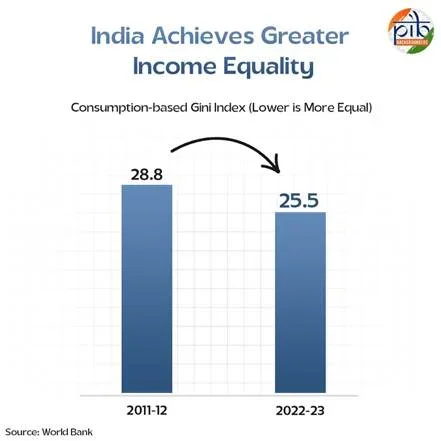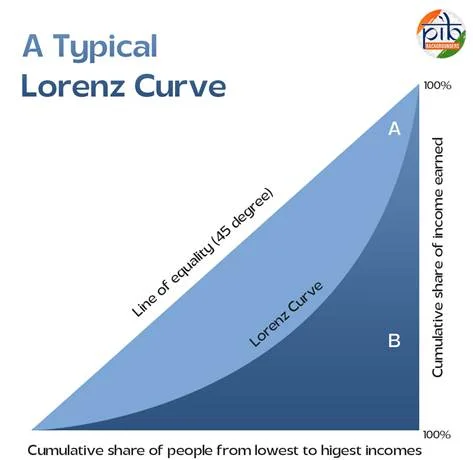Social Justice
India Becomes 4th ‘Most Equal’ Country Globally
- 08 Jul 2025
- 10 min read
For Prelims: World Bank, Gini Index, Jan Dhan accounts, Ayushman Cards, BharatNet, Ayushman Bharat Digital Mission
For Mains: Income inequality and the Gini Index, Role of social welfare schemes in poverty reduction, Inclusive Growth
Why in News?
India is not only the world’s fourth-largest economy but is also ranked among the most equal societies today. According to the World Bank, India’s Gini Index stands at 25.5, making it the fourth most equal country globally.
What is the Gini Index?
- About: The Gini index, or Gini coefficient, was developed in 1912 by Italian statistician Corrado Gini. It measures income inequality within a population.
- The index is derived from the Lorenz curve, which plots the cumulative percentage of total income received against the cumulative percentage of recipients, starting with the poorest.
- The Gini coefficient quantifies the area between the Lorenz curve and the line of perfect equality (a 45-degree line), with values ranging from 0 (perfect equality) to 1 (maximum inequality), or 0 to 100 when expressed as a percentage (where 0 indicates perfect equality and 100 indicates maximum inequality). A lower Gini value reflects a more equitable society.
- India and Gini Index: India’s Gini Index was 28.8 in 2011, declining steadily to 25.5 in 2022, reflecting consistent progress in social equity.
- India’s score of 25.5 places it in the “moderately low inequality” category (Gini scores between 25 and 30).
- Notably, India ranks ahead of countries with higher inequality scores, including China (35.7), and the US (41.8).
- Significance for India: India now ranks more equal than all G7 and G20 countries.
- The low score challenges conventional assumptions of India as a highly unequal society, particularly when viewed through urban-rural and inter-state disparities.
- It indicates broad-based income growth, particularly among the lower income brackets.
What are the Key Drivers Behind India’s Equity Success?
- Poverty Reduction: As per the World Bank’s Spring 2025 Poverty and Equity Brief, 171 million Indians have been lifted out of extreme poverty since 2011.
- The World Bank has revised its global extreme poverty threshold from USD 2.15/day to USD 3/day (based on 2021 prices) to account for global inflation. This new benchmark reflects a more realistic cost of basic living.
- At the USD 3/day threshold, India's extreme poverty rate for 2022–23 stands at 5.3%, down from 27.1% in 2011–12.
- In absolute terms, the number of people in extreme poverty fell from 344.47 million to 75.24 million.
- Welfare Schemes for Equity:
- PM Jan Dhan Yojana: Financial inclusion has been at the heart of India’s social equity push.
- As of June 2025 over 55.69 crore people hold Jan Dhan accounts, giving them direct access to government benefits and formal banking services.
- Aadhaar and Digital Identity: As of July 2025, more than 142 crore Aadhaar cards have been issued. This system forms the backbone of welfare delivery by ensuring that benefits reach the right person at the right time through reliable authentication.
- Direct Benefit Transfer (DBT): The DBT system has streamlined welfare payments, reducing leakages and delays. Cumulative savings have reached Rs 3.48 lakh crore as of 2023, reflecting its efficiency and scale.
- Ayushman Bharat: Provides health coverage of up to ₹5 lakh per family per year. As of July 2025, over 41.34 crore Ayushman Cards have been issued.
- The Ayushman Bharat Digital Mission has further strengthened this effort, with over 79 crore health accounts created to link individuals to digital health services.
- Stand-Up India: As of July 2025, more than 2.75 lakh applications have been sanctioned, with total funding of Rs 62,807 crore. This initiative empowers individuals from disadvantaged communities to participate in economic growth on their own terms.
- Pradhan Mantri Garib Kalyan Anna Yojana (PMGKAY): As of 2024, the scheme has reached 80.67 crore beneficiaries, offering free food grains and ensuring that no one is left behind during times of crisis.
- PM Vishwakarma Yojana: Traditional artisans and craftspeople are vital to India’s economic and cultural fabric. The PM Vishwakarma Yojana supports them with collateral-free loans, toolkits, digital training, and marketing support.
- As of July 2025, 29.95 lakh individuals have registered under the scheme, helping preserve livelihoods and promote inclusive growth across rural and semi-urban areas.
- PM Jan Dhan Yojana: Financial inclusion has been at the heart of India’s social equity push.
What are the Challenges and Structural Concerns Undermining India’s Equity Achievements?
- High Poverty Despite Low Inequality Index: At the USD 3.65/day poverty threshold (suitable for lower-middle-income countries), India’s poverty rate was 28.1% in 2022.
- Over 300 million people still live in poverty, questioning the sustainability of equality claims.
- Wage and Income Disparity: Wage disparity remains significant, the top 10% earn 13 times more than the bottom 10% (2023–24).
- The Gini coefficient for income in 2023 is 0.410, higher than 0.371 in 1955, showing a long-term rise in income inequality.
- The richest 1% hold over 40% of total national wealth, while the bottom 50% own only 3%.
- These highlight deep income and wealth inequality, which consumption-based measures like the Gini Index of 25.5 may not fully reflect.
- Outdated Poverty Line: India still relies on the Rangarajan Committee’s 2014 poverty line (estimated as Monthly Per Capita Expenditure of Rs. 1407 in urban areas and Rs. 972 in rural areas), which may not reflect current cost-of-living realities.
- Without an updated benchmark, welfare schemes may not adequately target the truly poor.
- Unequal Access to Opportunities: Gaps persist in education, healthcare, digital access, and employment, especially for rural populations, women, SCs/STs, and informal workers.
- Equality in outcomes remains limited despite improvements in consumption.
- Equality in outcomes remains limited despite improvements in consumption.
Way Forward
- Revise National Poverty Line: The poverty line is outdated. It must be recalibrated to reflect the 2024–25 cost-of-living realities, inflation, and urbanisation trends.
- Strengthen Labour Market Protections: Ensure fair wages, social security, and labour rights enforcement, especially in the informal sector that employs over 80% of the workforce
- Boost Public Investment in Education and Health: Increase allocation to Sarva Shiksha Abhiyan, PM SHRI, National Health Mission, and nutrition schemes to address intergenerational poverty and inequality.
- Bridge the Digital Divide: Expand BharatNet, digital literacy, and access to affordable smartphones/internet to ensure digital equity, especially for rural youth and women.
- Gender Inequality: Provide economic and policy measures to value women’s unpaid labor. Improve women’s access to education, healthcare, land, and credit to reduce the gender gap in opportunities.
Conclusion
India’s Gini score of 25.5 reflects real progress in bridging inequality through balanced economic reform and social protection. Schemes like Jan Dhan, DBT, and Ayushman Bharat have improved access, while Stand-Up India and PM Vishwakarma Yojana promote self-reliance. India’s model shows that growth and equality can advance together with inclusive policies.
|
Drishti Mains Question: India is ranked among the most equal nations globally. Examine the key policy measures and welfare schemes that have contributed to this achievement. |
UPSC Civil Services Examination, Previous Year Question (PYQ)
Mains:
Q. COVID-19 pandemic accelerated class inequalities and poverty in India. Comment. (2020)









